Working Their Thermal MagIC: Digging Into the Details of an Ambitious New ‘Thermometry Camera’
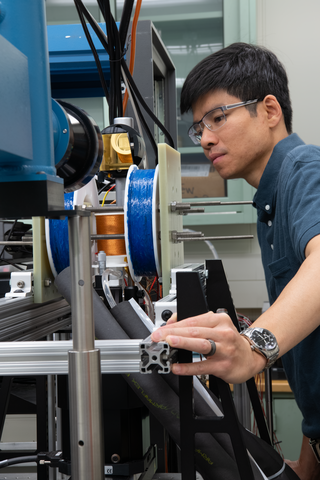
Thinh Bui with the Thermal MagIC system. The nanoparticle thermometers are suspended in liquid that’s been piped into tiny wells drilled into a quartz glass cube about the size of a paperweight. This cube sits in the middle of a coil (gold-colored, center). You can see the cube reflected in the mirror above the coil. The tiny wells in this cube form the letters “T” and “M,” which stand for “Thermal MagIC.” Additional coils (blue) surround the cube, providing changing electromagnetic fields that allow the researchers to scan the 3D image point by point. Finally, the nanoparticles are exposed to different temperatures by liquid cooling via the tubing visible beneath the coils.
Thermometers can do a lot of things: measure the temperature at the center of your perfectly braised chicken or tell you whether to keep your child home from school due to illness. But because of their size, traditional thermometers’ uses are still limited.
“How do you non-invasively measure a temperature inside a living system such as a human?” said NIST’s Thinh Bui. “Or in other environments that may be hard to access – say, the temperature inside a Kevlar vest as a bullet penetrates it. How do you have access to that? You can't stick a traditional thermometer in there.”
If researchers had a thermometry system that could measure tiny changes in temperature, with high spatial resolution, inside objects opaque to light, that could potentially revolutionize the fields of medicine and manufacturing.
To address these needs, NIST researchers are working on an ambitious project called Thermal Magnetic Imaging and Control, or “Thermal MagIC.” Thermal MagIC measures the magnetic responses of nano-sized (on the order of billionths of a meter) spheres, made of metal or other substances, embedded in the object whose temperature is being measured. The magnetic signals collected by the system correspond to specific temperatures. Going beyond simply measuring temperature, the Thermal MagIC researchers aim to make a thermometer with high spatial resolution – a temperature imaging system.
Four years and many milestones into the project, the research team has just published a paper fully characterizing the temperature sensitivity and spatial resolution of their imaging system, a necessary step toward making a reliable “thermometry camera.” The paper was published last week in Scientific Reports.
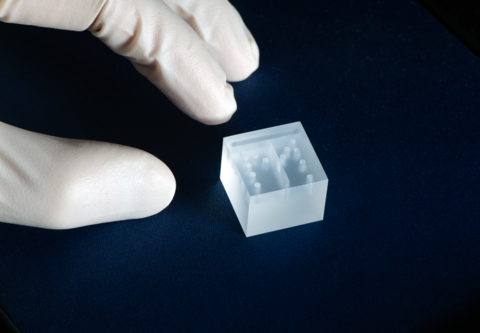
“The goal of Thermal MagIC is to develop a general technique for temperature imaging and temperature measurements in perhaps some of the most challenging environments that you can have,” Bui said. “I'm pleased with how things have gone so far. You take little steps for a long time and then suddenly there's a big jump, leading us to discoveries that take us to the root of how the best spatial image resolution can be achieved with magnetic imaging.”
Thermal MagIC consists of two systems working together:
The first part consists of the sensors themselves: nanometer-sized spheres whose magnetic signals change with temperature. These tiny particles, made of iron oxide, would be incorporated into the liquids or solids being studied.
The second part comprises the instrument that excites the tiny spheres magnetically and then reads out their signal. [See animation.]
Every kind of imaging system – whether it’s a microscope or a telescope, or in this case a magnetic particle imager – has a limit to its spatial resolution; it can’t see objects smaller than a certain size. To test this limit in Thermal MagIC, Bui and colleagues first put their nanoparticles into a series of tiny wells – in clusters of fours – filled with solution. Each well in a foursome was spaced away from the other wells by a certain amount, anywhere from 0.1 mm (very close together) to 1 mm (further apart).
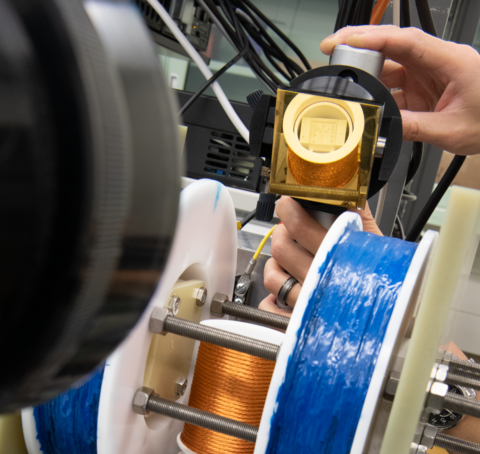
Sometimes, the imager could pick out each of the four wells distinctly. Other times, the foursome merged together into one or two blobs. The researchers tested which parts of the signal best distinguished the wells from each other.
One key part of the signal researchers can pick up in their Thermal MagIC system is its harmonics.
Those with musical training might already be familiar with the term. A single note played with a clarinet has one primary frequency of sound – the main note, say an “A-flat.” But that tone also contains a series of other, fainter frequencies – harmonics of the main note – that give the clarinet its distinctive sound quality. A clarinet and an oboe might be playing the same note, but they sound distinct from one another thanks to their different harmonics, which arise from differences in the instruments’ shapes and sizes and the materials used to make them.
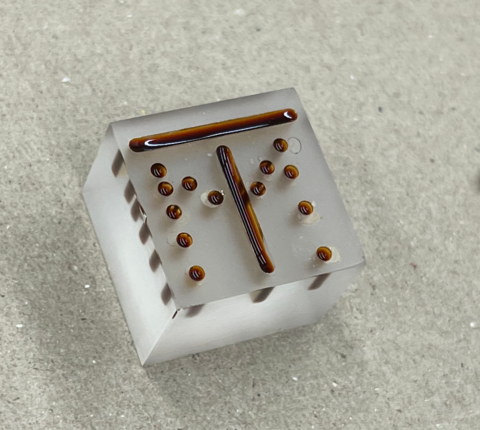
Harmonics in the magnetic signals from the nanoparticles in Thermal MagIC work in a similar way. In this case, though, the main frequency is not sound waves but a pulsing magnetic signal produced by the nanoparticles. The harmonics are pulsing magnetic signals of higher frequencies, produced by a unique recipe of materials and conditions in the system.
The same nanoparticle could be exposed to the same magnetic excitation. But depending on the temperature to which the particle was exposed, its magnetic harmonics would be different: The colder nanoparticle might “sound” like a clarinet, but the warmer nanoparticle might “sound” like an oboe.
In the current study, researchers found that measuring higher harmonics (the harmonic signals with higher frequencies) rather than lower harmonics gave them better spatial resolution – that is, they were able to distinguish the four wells from each other even when they were spaced quite close together (see graphic below). Measuring the ratio of a higher harmonic to a lower harmonic gave them an even clearer picture.
With this setup, they were able to assess temperature differences to within just 500 millikelvin (thousandths of a kelvin) in a volume of just 63 nanoliters (billionths of a liter).
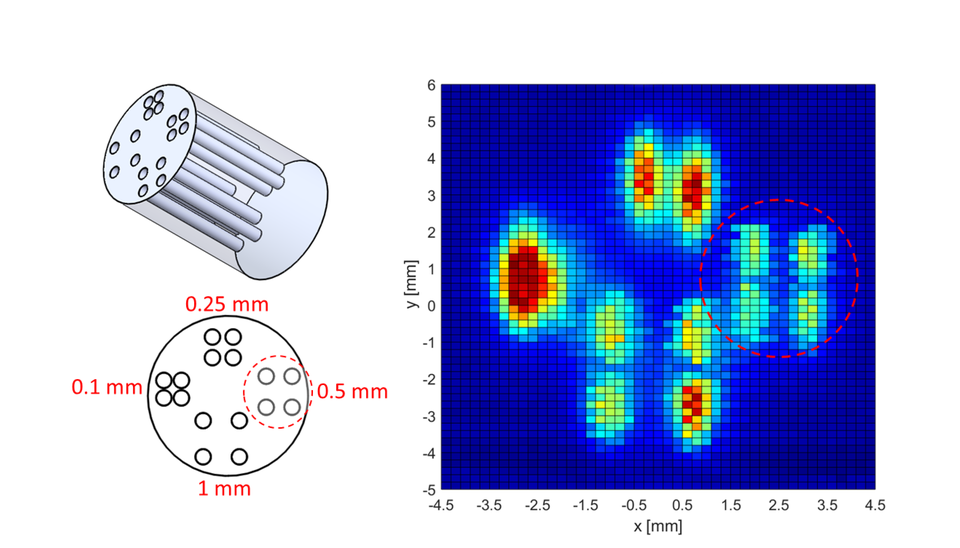
The paper’s authors include Thinh Bui, Mark-Alexander Henn, Weston Tew, Megan Catterton, and Solomon Woods.
The next big milestone will be the first measurement over a temperature gradient, which would allow Thermal MagIC to graduate to a true temperature imaging system.
“So far, I’ve measured a sample of nanoparticles at one single temperature at a time,” Bui said. “True thermal imaging requires a system that has many temperatures across different local regions, and then quantifying and imaging the variations across the local regions. And that's what we're endeavoring to do in the coming months.”
--Reported and written by Jennifer Lauren Lee
Paper: T.Q. Bui, M.-A. Henn, W.L. Tew, M.A. Catterton, and S.I. Woods. Harmonic dependence of thermal magnetic particle imaging. Scientific Reports. Published online September 22, 2023. DOI: https://doi.org/10.1038/s41598-023-42620-1

